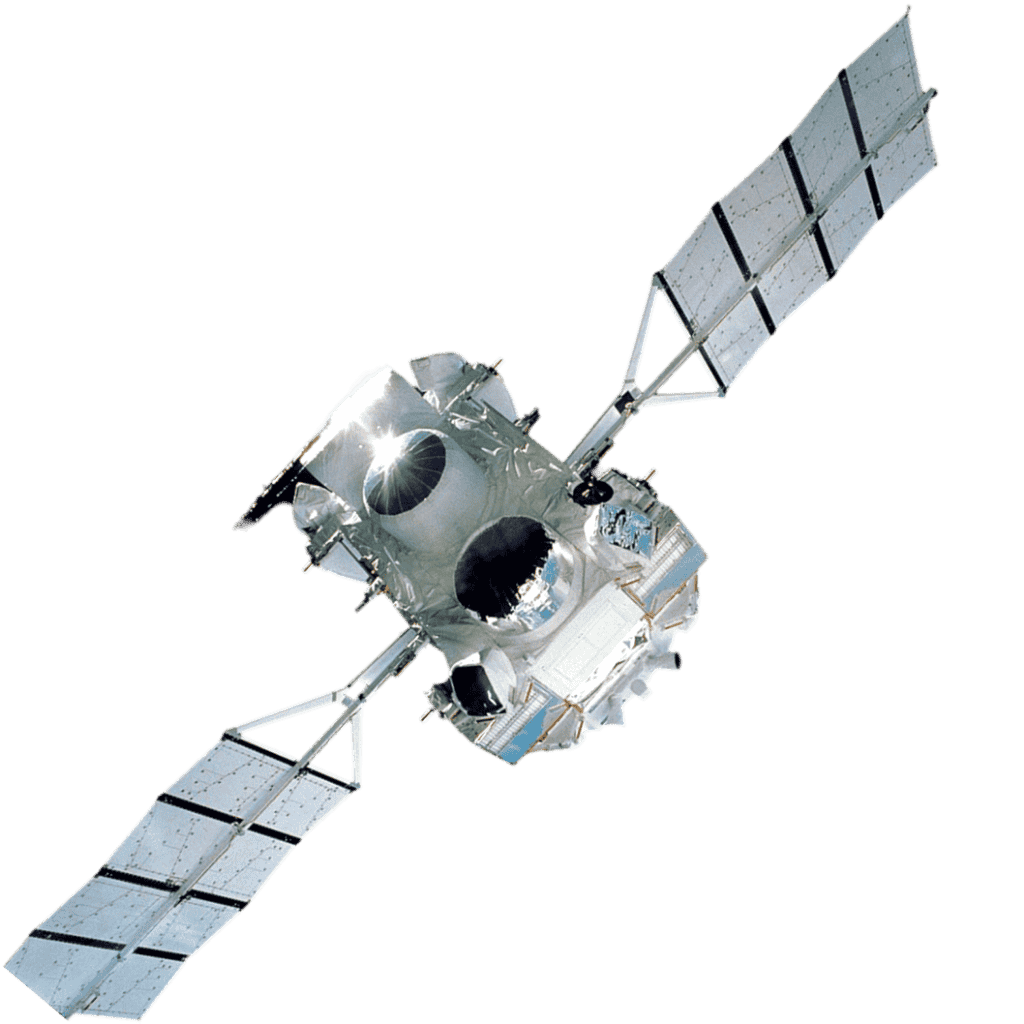Compton Gamma Ray Observatory
Gamma-Ray Pioneer
Gamma-ray telescope studying high-energy cosmic sources

USPs
- First comprehensive gamma-ray sky survey
- Studied pulsars, quasars, and gamma-ray bursts
- Part of NASA’s Great Observatories program
- Four instruments: BATSE, OSSE, COMPTEL, EGRET
- Mapped thousands of gamma-ray sources
- Discovered isotropic distribution of gamma-ray bursts
- Enabled multi-wavelength studies of high-energy phenomena
Major Milestones
- 1991-04-05: Launched aboard the Space Shuttle Atlantis during STS-37, initiating its mission to study gamma-ray sources across the universe.
- 1991-04-07: Deployed into a low Earth orbit at 450 km altitude and activated its four instruments: BATSE, OSSE, COMPTEL, and EGRET.
- 1991-06-01: Began its first all-sky survey, detecting gamma-ray bursts and providing initial data on high-energy cosmic phenomena.
- 1992-03: Published the first catalog of gamma-ray bursts, identifying over 200 events and establishing their isotropic distribution.
- 1994-10: Detected the gamma-ray afterglow of a gamma-ray burst (GRB 940217), offering insights into their relativistic nature.
- 1997-06: Observed the gamma-ray emission from the active galaxy 3C 279, revealing details about supermassive black holes.
- 1999-03: Completed its primary mission, having conducted over 10,000 observations and mapped the gamma-ray sky.
- 2000-06-04: Deorbited into the Pacific Ocean after a controlled reentry, ending its mission due to a gyroscope failure and safety concerns.
- 2002-01: Data archive released, providing a comprehensive dataset for studying gamma-ray astrophysics.
- 2025-07-17: Data continues to be analyzed, influencing ongoing research into gamma-ray bursts and high-energy astrophysics as of today.
Cosmic Portrait
Compton Gamma Ray Observatory: High-Energy Explorer
Compton Gamma Ray Observatory (CGRO), launched by NASA in April 1991, was one of the four iconic Great Observatories, alongside Hubble, Chandra, and Spitzer. It was the first major space telescope dedicated entirely to observing gamma-ray sources—the universe’s most energetic and extreme phenomena. Operating for nearly a decade, CGRO transformed our understanding of high-energy astrophysics and left behind a legacy that still shapes gamma-ray astronomy today.
- Scientific Contributions: Compton conducted the first-ever comprehensive gamma-ray sky survey, detecting thousands of sources previously hidden from view. It observed pulsars, quasars, gamma-ray bursts (GRBs), and active galactic nuclei, expanding our catalog of energetic cosmic events and helping to identify mysterious high-energy objects across the sky.
- Instruments & Capabilities: CGRO housed four main instruments—BATSE, OSSE, COMPTEL, and EGRET—each targeting different energy ranges from 20 keV to 30 GeV. Together, they offered an unparalleled window into the violent universe, capturing data on nuclear reactions, matter-antimatter annihilation, and cosmic explosions in real time.
- Orbit & Observation: Positioned in low Earth orbit, the spacecraft had a stable vantage point to continuously monitor high-energy phenomena without atmospheric interference. Its instruments operated simultaneously, providing multi-spectrum gamma-ray coverage never before achieved.
- Legacy & Achievements: Over its mission lifespan, Compton helped confirm that gamma-ray bursts originate from distant galaxies, not within the Milky Way as once thought. It also uncovered hundreds of blazars and high-energy supernova remnants, and offered vital insights into the early universe and the lifecycle of massive stars.
End of Mission and Continuing Impact
After years of groundbreaking work, Compton was decommissioned in June 2000 due to the failure of one of its three gyroscopes. Rather than risk uncontrolled re-entry, NASA made the difficult decision to safely deorbit the spacecraft, and it burned up over the Pacific Ocean. Despite its end, the data gathered by CGRO continues to influence space science. Its comprehensive all-sky maps and GRB catalogs are still referenced in modern studies and laid the foundation for successor missions like Fermi Gamma-ray Space Telescope and INTEGRAL.
Why Compton Still Matters
Compton illuminated the universe’s most violent events, from exploding stars to black holes—charting the cosmos in high-energy light for the first time in history.
By opening a window into the gamma-ray universe, CGRO helped scientists probe the extreme edges of astrophysics—from matter jets traveling at near-light speed to particles accelerated by black holes. Its impact wasn’t just scientific—it marked a technological leap in how we explore the invisible, high-energy frontier of space. Compton remains a cornerstone in the timeline of modern astronomy and continues to inspire new generations of gamma-ray missions.
Fun Fact
Compton detected gamma-ray bursts from the edge of the universe!